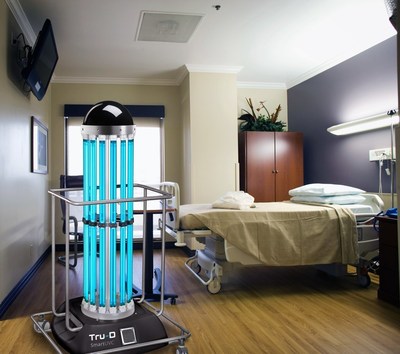Measured-dose UV light provides higher pathogen reduction
MEMPHIS, Tenn., Feb. 1, 2016 /PRNewswire/ — Disinfecting surfaces in hospital rooms, especially high-touch areas, has been proven critical to reducing the transmission of health care-associated infections, yet chemical cleaning products and processes have not been able to slow the spread of multidrug-resistant organisms.

What if technology existed that had the eyes to see, the brain to analyze and the power to destroy these pathogens being left behind?
It does exist.
Enter Tru-D SmartUVC—a UV disinfection system that delivers an automated, measured dose of UV to consistently disinfect an entire room from a single position. The patented Sensor360 technology ensures 99.99 percent pathogen reduction in direct and shadowed areas, with the capability to document disinfection results for each cycle.
Throughout the last decade, emerging technologies like hydrogen peroxide vapor and UV disinfection have entered the market in an effort to make up for human error. While hydrogen peroxide vapor has had good success in disinfection numbers, it is labor-intensive, may be caustic to delicate instruments and takes more than four times longer than UV devices to complete disinfection, prolonging room turnover time and reducing hospital productivity. Also, when compared directly to HPV devices, Tru-D SmartUVC was noted as easier to use, with significantly shorter cycle times and the ability to be administered by personnel with only limited training. Tru-D additionally does not require monitoring by personnel during the disinfection process.
In October 2015, research leaders in UV disinfection released the results of the first randomized clinical trial on UV disinfection, which was funded by the Centers for Disease Control and Prevention. Overall, results of the landmark Benefits of Enhanced Terminal Room Disinfection study showed that enhanced terminal room disinfection strategies decreased the cumulative incidence of multidrug-resistant organisms by 10 to 30 percent, and the largest decreases were seen when Tru-D SmartUVC, the only device chosen for the study, was added to the standard cleaning strategy. It also showed that the process of incorporating Tru-D into hospital disinfection protocols for highest risk rooms was seamless, and adding a cycle of UV dosing only added up to 10 minutes to the total room turnover time.
"While hospitals must dutifully adhere to CDC protocols, the research shows they would be remiss to not use proven measured-dose UV disinfection technology available to them to protect patients and staff from what standard terminal cleaning processes can leave behind," said Chuck Dunn, president and CEO of Tru-D SmartUVC LLC. "The results of the BETR-D study shined a bright light on the future of UV disinfection, and we look forward to the possibility of it one day being a CDC-recommended standard terminal cleaning process."
For more information, visit tru-d.com.
About Tru-D SmartUVC
Tru-D SmartUVC is the only UV disinfection device backed by a CDC-funded randomized clinical trial showing its capability of reducing the transmission of health care-associated infections by up to 30 percent. More than 300 Tru-Ds have been deployed to disinfect hospitals across the globe, fighting deadly pathogens such as MRSA, CRE, C. diff, VRE, MERS, Ebola and many more. An effective and innovative technology backed by sound science, Tru-D SmartUVC is on a mission to eradicate HAIs making hospitals a safer place for patients and staff. For information and links to independent studies on Tru-D, visit www.Tru-D.com.
MEDIA RELEASE
Christin Yates
Tru-D Public Relations
901-774-5771
Email

Photo – http://photos.prnewswire.com/prnh/20160129/327409
Logo – http://photos.prnewswire.com/prnh/20160129/327410LOGO